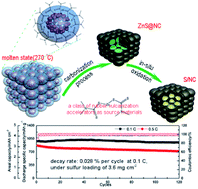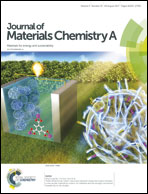A novel synthetic route to cathode materials for Li–S batteries: from organic sulfides to sulfur/nitrogenous carbon composites†
Abstract
Despite the promising high energy density at low cost, lithium sulfur batteries suffer from the fatal shuttle effect caused by intermediate dissolution during cycling, significantly shortening their cycle life. Herein, we report a facile synthesis of sulfur/carbon composites. Through a one-step calcination, nano-sized ZnS particles coated with nitrogenous carbon are directly prepared from cheap industrial rubber vulcanization accelerators (a kind of organic sulfide), and then in situ oxidized to obtain nitrogenous carbon coated sulfur composites, with a three dimensional cell-stacked structure. This particular frame with a high level of in situ introduced polar functional groups provides abundant obstacles and chemical traps to effectively immobilize the intermediates, allowing for excellent storage performance and long-term cycle life. Outstandingly, the composite exhibits a remarkably low decay rate of 0.028% per cycle after 120 cycles at 0.1C-rate, under the sulfur loading of 3.6 mg cm−2.

- This article is part of the themed collection: 2017 Journal of Materials Chemistry A HOT Papers


 Please wait while we load your content...
Please wait while we load your content...